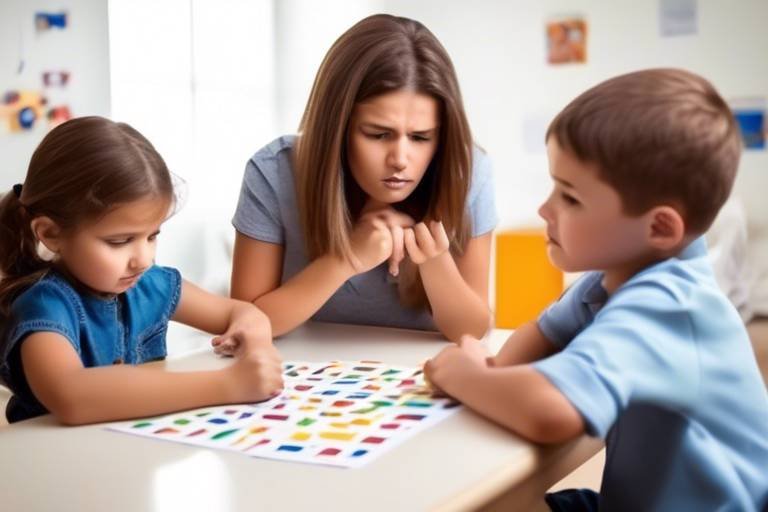How To Help Your Child Develop Good Study Habits
Every parent dreams of their child achieving academic success, but how do we get there? The answer lies in fostering good study habits. Just like a gardener nurtures a plant to help it grow strong and healthy, parents can cultivate effective study practices that will not only help their children excel in school but also prepare them for lifelong learning. In this article, we'll explore practical strategies that can make a significant difference in your child's educational journey.
So, what exactly are study habits? At their core, study habits are the routines and practices that students develop to enhance their learning. These habits can include everything from the time of day they study, to the methods they use to absorb information. Why do they matter? Well, think of study habits as the foundation of a house. Without a solid foundation, the house can't stand strong against the storms of academic challenges. Good study habits can lead to improved grades, better retention of information, and a more positive attitude towards learning.
Imagine trying to concentrate on a puzzle while a TV is blaring in the background. Frustrating, right? This is why a conducive study environment is crucial. It's essential to create a dedicated study space that minimizes distractions and enhances focus. Here are some tips to help you set up the perfect study nook for your child:
- Choose a quiet location away from the hustle and bustle of the household.
- Ensure the area is well-lit, preferably with natural light.
- Keep the space organized and clutter-free to promote a clear mind.
Now that the environment is set, let’s talk about organization. Keeping study materials in order can significantly improve your child’s efficiency. Imagine searching for a book in a messy room—it can be a daunting task! To avoid this, consider implementing strategies such as:
- Using bins or folders for different subjects.
- Creating a designated spot for supplies like pens, highlighters, and notebooks.
- Utilizing a calendar to track assignments and deadlines.
In today's digital age, there are countless apps and tools designed to streamline organization. Tools like Google Drive for document storage or Trello for task management can be game-changers. These platforms not only help keep materials organized but also teach children valuable skills in digital literacy.
While digital tools are fantastic, let’s not forget about the value of physical organization. Techniques like color-coding notes or labeling folders can make a world of difference. For instance, using different colors for each subject can help children quickly identify what they need, just like a traffic light guiding them safely along the road.
Consistency is key when it comes to developing good study habits. Establishing a daily routine helps children understand when it’s time to buckle down and focus. A balanced schedule that includes study time, breaks, and leisure activities ensures that your child doesn’t burn out. Think of it like a well-balanced diet; each component is essential for overall health. Encourage your child to stick to a routine, and they'll likely find studying becomes easier over time.
Active learning is like a vibrant conversation, while passive learning resembles a one-sided lecture. Engaging your child in active learning techniques can significantly enhance their understanding and retention of material. Strategies such as summarizing what they’ve learned, asking questions, and even teaching the material to someone else can deepen their comprehension. It’s like turning the lights on in a dark room; suddenly, everything becomes clearer!
Technology can be a fantastic ally in active learning. Integrating educational apps and online resources can make studying more interactive and enjoyable. For instance, platforms like Khan Academy offer a plethora of resources that cater to various learning styles. The key is to find tools that resonate with your child's interests and needs, transforming study time from a chore into an adventure.
Studying with peers can be incredibly beneficial. Think of it as a team sport; collaboration can foster motivation and make learning more enjoyable. Facilitate productive study groups for your child and their friends, where they can share insights and tackle challenging concepts together. This not only reinforces their understanding but also builds social skills that are essential for their overall development.
Q: How can I motivate my child to study?
A: Try to make studying enjoyable by incorporating games or interactive activities. Celebrate small achievements to keep their spirits high.
Q: What if my child resists studying?
A: It's important to understand the root of their resistance. Have open conversations about their feelings and try to address any underlying issues.
Q: Are study habits the same for every child?
A: No, every child is unique. It's vital to tailor study strategies to fit your child's individual learning style and preferences.

Understanding Study Habits
This article provides practical strategies and insights for parents to foster effective study habits in their children, setting them up for academic success and lifelong learning.
When we talk about study habits, we're diving into the very essence of how our children learn and retain information. Study habits are the routines and practices that students develop to help them study effectively. Think of them as the building blocks for academic achievement. Just like a chef needs the right ingredients to whip up a delicious meal, your child needs solid study habits to succeed in school.
But why do these habits matter? Well, they can significantly influence a child's learning process and overall performance. Imagine trying to build a house without a solid foundation; the same goes for studying. Without good habits, your child may struggle with time management, organization, and focus, which can lead to stress and poor academic results.
Research shows that students with well-established study habits tend to perform better academically. They are more likely to complete assignments on time, prepare for exams effectively, and engage in class discussions. This isn't just about grades; it's about fostering a love for learning and curiosity that lasts a lifetime. So, what are the key components of effective study habits? Let's break it down:
- Consistency: Regular study times help children know when to focus and when to relax.
- Organization: Keeping materials in order can save time and reduce frustration.
- Active Engagement: Techniques that involve interaction with the material can lead to better understanding.
By helping your child develop these essential habits, you're not just preparing them for tests and quizzes; you're setting them up for success in all areas of life. Good study habits can lead to improved self-discipline, better time management skills, and a sense of responsibility that carries over into adulthood. So, how can you help nurture these habits? It all starts with creating the right environment and providing the right tools.
Ultimately, understanding study habits is about recognizing their value in your child's education. By fostering these practices early on, you're giving your child a gift that will serve them well throughout their academic journey and beyond.
A conducive study environment is crucial for focus and productivity. Here, we discuss tips for setting up a dedicated study space that minimizes distractions and enhances concentration for your child.
Keeping study materials organized can significantly improve efficiency. This subsection covers strategies for organizing books, notes, and supplies to help your child find what they need quickly and easily.
In the digital age, using apps and tools can streamline organization. This section highlights effective digital tools that can help children manage their study materials and schedules more efficiently.
Physical organization remains important alongside digital methods. Here, we explore techniques like color-coding and labeling that can aid children in maintaining a tidy and accessible study space.
A consistent study routine helps children develop discipline. This section emphasizes the importance of regular study times and how to create a balanced schedule that includes breaks and leisure activities.
Active learning techniques engage children more effectively than passive methods. This section introduces strategies such as summarizing, questioning, and teaching others to deepen understanding and retention of material.
Technology can enhance active learning experiences. Here, we discuss how to integrate educational apps and online resources to make studying more interactive and enjoyable for your child.
Studying with peers can foster collaboration and motivation. This subsection explores the benefits of group study sessions and how to facilitate productive study groups for your child and their friends.
Here are some common questions parents may have about helping their children develop good study habits:
- What age should I start teaching my child study habits? It's never too early! Start as soon as they begin school.
- How can I motivate my child to stick to their study routine? Use positive reinforcement and set achievable goals together.
- What if my child prefers to study in a noisy environment? Some kids thrive in noise, but if it distracts them, try using noise-canceling headphones.

Creating a Study Environment
When it comes to fostering effective study habits, creating the right environment is absolutely crucial. Think of your child's study space as a blank canvas; it has the potential to either inspire creativity and focus or lead to distractions and frustration. The goal is to design a space that not only minimizes distractions but also promotes concentration and productivity. So, how do you go about crafting this ideal study environment? Let's dive into some practical strategies!
First and foremost, it's essential to choose a dedicated area for studying. This could be a specific room, a corner of their bedroom, or even a cozy nook in the living room. The key is to ensure that this space is consistent and free from interruptions. Imagine trying to paint a masterpiece in a crowded café—it's nearly impossible! Similarly, your child needs a space that feels separate from the hustle and bustle of daily life.
Next, lighting plays a significant role in creating an inviting study atmosphere. Natural light is often the best option, as it helps to keep energy levels high and mood elevated. However, if that's not feasible, consider investing in a good desk lamp with adjustable brightness. A well-lit space can make a world of difference, transforming a dreary study session into an engaging experience.
Another important aspect is to keep the study area organized and clutter-free. A messy environment can lead to a cluttered mind, making it harder for your child to focus. Encourage your child to keep their desk tidy by regularly sorting through papers and supplies. You might even consider implementing some organization techniques, such as:
- Color-coding: Assign different colors for different subjects to make it visually appealing and easy to locate materials.
- Labeling: Use labels on storage bins and folders to help your child quickly find what they need.
Moreover, incorporating comfortable furniture is essential. A supportive chair and a spacious desk can make studying much more pleasant. Think about it this way: would you want to sit on an uncomfortable chair for hours while trying to learn? Probably not! Investing in ergonomic furniture can enhance your child's study experience and help them maintain focus for longer periods.
Lastly, consider adding personal touches to the study area. Encourage your child to decorate their space with motivational quotes, artwork, or anything that inspires them. This personalization can create a sense of ownership and make the study environment feel more inviting. After all, a space that reflects their personality can be a powerful motivator!
In summary, creating a study environment involves a mix of practicality and personalization. By choosing the right location, ensuring proper lighting, maintaining organization, investing in comfortable furniture, and adding personal touches, you can help your child cultivate a space that enhances their focus and productivity. Remember, the goal is to make studying a more enjoyable and effective experience!

Organizing Study Materials
Keeping study materials organized is not just a matter of tidiness; it’s about creating an environment where your child can thrive academically. Imagine trying to read a book in a messy room—distractions are everywhere, and focus becomes a challenge. By helping your child organize their study materials, you're essentially creating a roadmap for their learning journey. This roadmap allows them to navigate through their studies with ease and confidence.
Start by encouraging your child to categorize their materials. This can include books, notes, and supplies. For instance, you might suggest using different folders or binders for each subject. Color-coding these folders can make it visually appealing and easy to identify at a glance. For example, blue for math, green for science, and red for language arts. This method not only keeps things organized but also reinforces their learning by associating colors with subjects.
Another effective strategy is to establish a designated study area. This space should be free from distractions and equipped with all necessary supplies. Think of it as their personal command center for learning. It should include:
- A sturdy desk or table with good lighting
- All essential stationery like pens, pencils, and highlighters
- Reference materials such as dictionaries or textbooks
In addition to physical organization, consider teaching your child about digital organization tools. In today’s tech-savvy world, apps like Evernote, Google Drive, or Trello can be invaluable. These tools allow students to keep their notes, assignments, and schedules in one accessible location. By integrating technology into their study habits, your child can learn to manage their time and materials more efficiently, making them feel empowered and in control.
Furthermore, it’s essential to regularly review and declutter their study materials. Encourage your child to set aside time each month to go through their supplies and notes. This not only keeps their space tidy but also helps them reflect on what they’ve learned and what they still need to focus on. Think of it as a mini spring cleaning for their brain—clearing out the old to make way for new knowledge!
By instilling these organizational habits early on, you're not just helping your child with their current studies; you're equipping them with skills that will serve them well throughout their academic journey and beyond. After all, a well-organized study space can be the difference between feeling overwhelmed and feeling ready to tackle any challenge that comes their way.

Digital Organization Tools
In today's fast-paced world, digital organization tools have become a game-changer for students of all ages. These tools not only help streamline study materials and schedules but also make learning more engaging and interactive. Imagine trying to navigate through a messy room filled with clutter; it can be overwhelming, right? The same goes for a child's study materials. By leveraging technology, parents can help their children create a more organized and efficient study routine.
One of the most popular digital organization tools is the use of note-taking apps. Applications like Evernote and Microsoft OneNote allow students to jot down notes, categorize them by subject, and even sync them across multiple devices. This means that whether your child is studying at home or on the go, their notes are always accessible. Furthermore, these apps often support multimedia elements, enabling students to include images, audio recordings, and links, thus enriching their study materials.
Another fantastic tool is the calendar app. Tools like Google Calendar or Apple Calendar can help children keep track of their assignments, deadlines, and study sessions. By setting reminders and alerts, parents can ensure that their children remain on top of their responsibilities. It's like having a personal assistant that nudges them to stay focused and organized. Additionally, these calendar apps can be shared with parents, allowing for better oversight and support.
To take it a step further, consider project management tools such as Trello or Asana. These platforms allow students to create boards for different subjects, breaking down their tasks into manageable pieces. For instance, they can create a board for a science project, listing out tasks like research, drafting, and final presentation. This not only helps in keeping track of what needs to be done but also instills a sense of accomplishment as they check off completed tasks.
Lastly, don't overlook the power of cloud storage services like Google Drive or Dropbox. These platforms provide a safe space for students to store their documents, ensuring that important files are not lost. They also allow for easy sharing with classmates for collaborative projects. Imagine your child working on a group assignment and effortlessly sharing their work with peers, all while being able to access it from any device. It’s a win-win!
In summary, digital organization tools are essential for fostering effective study habits. By incorporating these tools into your child's routine, you not only help them stay organized but also make learning a more enjoyable and interactive experience. Embrace technology, and watch as your child transforms their study habits into a well-oiled machine!
1. What are some effective digital organization tools for students?
Some effective tools include note-taking apps like Evernote, calendar apps like Google Calendar, project management tools like Trello, and cloud storage services like Google Drive.
2. How can I help my child get started with these tools?
Start by introducing one tool at a time. Show them how to use it in a fun and engaging way, and encourage them to explore its features.
3. Are there any costs associated with these digital tools?
Many digital organization tools offer free versions with basic features, while premium versions may require a subscription. It's best to start with free versions to see what fits your child's needs.
4. Can these tools help with time management?
Absolutely! Calendar and project management tools are specifically designed to help students manage their time effectively by setting deadlines and reminders.
5. How do I ensure my child stays focused while using digital tools?
Set specific goals for study sessions and encourage breaks. Also, monitor their screen time and help them find a balance between study and leisure activities.

Physical Organization Techniques
When it comes to creating a study environment that fosters productivity, physical organization plays a pivotal role. Imagine walking into a cluttered room where books are scattered, and papers are piled high; it’s overwhelming, right? Now, picture the opposite: a neatly arranged study space where everything has its place. This can significantly influence your child's ability to focus and absorb information. Here are some effective techniques to help your child maintain a tidy and accessible study area.
One of the simplest yet most effective methods is color-coding. By assigning different colors to various subjects or types of materials, your child can quickly identify what they need without digging through stacks of papers. For instance, they might use blue for math, green for science, and red for history. This not only makes finding materials easier but also adds a visual element that can help with memory retention.
Another strategy is labeling. Encourage your child to label folders, binders, and storage boxes. This can be particularly helpful for younger kids who may not yet have developed strong organizational skills. Labels can include the subject name, due dates for assignments, or even specific topics covered. By having everything clearly marked, your child can save precious time and reduce frustration when searching for materials.
In addition to color-coding and labeling, consider the importance of designating specific zones within the study space. For example, create a reading nook with a comfortable chair and good lighting, a desk area for writing, and a separate space for digital learning. This physical separation can help your child transition between different types of study activities, making it easier to stay focused and engaged.
Lastly, don't underestimate the power of regular maintenance. Set aside a few minutes each week for your child to tidy up their study area. This can involve sorting through papers, reorganizing supplies, and ensuring that everything is in its designated spot. By making this a routine, you instill a sense of responsibility and ownership over their study environment, which can lead to better habits in the long run.
In summary, physical organization techniques such as color-coding, labeling, designating zones, and regular maintenance can transform your child's study space into a haven for learning. With these strategies in place, your child will not only find it easier to locate their materials but will also develop a more positive attitude towards studying.
- What is the best way to encourage my child to keep their study area organized?
Lead by example and involve them in the organization process. Make it a fun activity by choosing colors and labels together. - How often should I help my child organize their study space?
Aim for a quick tidy-up weekly, but also encourage them to do small maintenance daily to keep clutter at bay. - Can digital tools replace physical organization?
While digital tools are helpful, physical organization is still crucial for creating a focused study environment.

Establishing a Routine
Establishing a consistent study routine is like laying down the tracks for a train; it sets the direction for your child's academic journey. Just as a train needs tracks to run smoothly, children need a structured schedule to navigate their studies effectively. A well-planned routine not only helps in developing discipline but also instills a sense of responsibility and time management. Imagine your child as a budding artist, with each study session being a stroke on their canvas of knowledge; without a routine, the masterpiece can quickly turn into a chaotic mess.
To kick off this journey, it’s essential to identify the best times for studying. Some children are natural night owls, while others shine in the morning light. Observing your child's peak productivity hours can significantly influence their study effectiveness. For instance, if your child is a morning person, scheduling study sessions right after breakfast can harness their energy and focus. On the flip side, if they thrive in the evening, setting aside time after dinner might work wonders. This flexibility not only respects their natural rhythms but also makes studying feel less like a chore and more like a part of their daily life.
Moreover, a balanced schedule is crucial. Just like a balanced diet is essential for physical health, a well-rounded routine should include study time, breaks, and leisure activities. Consider using a weekly planner to visualize their commitments. Here’s a simple example of how you can structure their weekly routine:
| Day | Study Time | Breaks | Leisure Activities |
|---|---|---|---|
| Monday | 4 PM - 6 PM | 15 mins after each hour | Soccer Practice |
| Tuesday | 4 PM - 6 PM | 15 mins after each hour | Video Games |
| Wednesday | 3 PM - 5 PM | 15 mins after each hour | Art Class |
| Thursday | 4 PM - 6 PM | 15 mins after each hour | Family Movie Night |
| Friday | 4 PM - 6 PM | 15 mins after each hour | Free Time |
| Saturday | 10 AM - 12 PM | 15 mins after each hour | Outdoor Activities |
| Sunday | 11 AM - 1 PM | 15 mins after each hour | Family Time |
In addition, it’s vital to encourage your child to stick to their routine as much as possible, but also to remain flexible. Life can throw unexpected events their way, and adapting to change is a critical skill. If they have a big test coming up, adjusting their schedule to allow for more study time is perfectly acceptable. On the other hand, if they feel overwhelmed, it’s equally important to remind them that it’s okay to take a step back and recharge.
Lastly, celebrate the small victories! When your child adheres to their routine, reward them with a little treat or a fun outing. This not only reinforces positive behavior but also makes the process enjoyable. Just as a gardener nurtures their plants to help them grow, you too can cultivate a productive study routine that will flourish and yield the fruits of academic success.

Encouraging Active Learning
Active learning is like a breath of fresh air in the often stale environment of traditional education. It transforms the learning process from a passive experience into an engaging adventure. When children actively participate in their learning, they not only absorb information more effectively but also develop critical thinking skills that will benefit them throughout their lives. So, how can you encourage your child to embrace this dynamic approach? Let's dive in!
One of the most effective strategies for fostering active learning is to encourage your child to summarize what they've learned. After studying a topic, ask them to explain it back to you in their own words. This technique not only reinforces their understanding but also highlights any areas that may need further clarification. Think of it as a mini teaching session—when they teach, they learn twice!
Another powerful method is to promote questioning. Encourage your child to ask questions about the material they are studying. This could mean digging deeper into a subject or even challenging the information presented. For instance, if they are learning about ecosystems, ask them why certain species thrive in specific environments. This kind of inquiry fosters curiosity and makes the learning process more interactive.
Moreover, teaching others is a fantastic way for children to solidify their knowledge. If your child has a younger sibling or a friend, suggest that they explain a concept they've just mastered. This not only reinforces their learning but also builds confidence. It’s like being a superhero for a moment—sharing knowledge and helping others grow!
Incorporating technology can also enhance active learning experiences. Educational apps and online resources can make studying more interactive and enjoyable. For example, platforms like Kahoot! allow students to create quizzes on various subjects, turning study sessions into fun competitions. This not only boosts engagement but also promotes a sense of community and collaboration among peers.
Lastly, consider organizing group study sessions. Studying with friends can be incredibly motivating and can lead to collaborative learning experiences. When kids work together, they can share different perspectives and techniques, enriching their understanding of the material. To facilitate productive study groups, ensure that there’s a clear agenda and goals for each session. This way, the time spent together is both enjoyable and educational.
In conclusion, encouraging active learning is all about making the educational experience engaging and interactive. By implementing these strategies, you can help your child develop a love for learning that lasts a lifetime. Remember, the more involved they are in their education, the more they will retain and enjoy the process!
- What is active learning? Active learning is an instructional approach that actively engages students in the learning process, encouraging them to participate and take responsibility for their learning.
- How can I encourage my child to ask questions? Create a safe space for discussion, where curiosity is welcomed and valued. Ask open-ended questions and model inquisitive behavior yourself.
- Are there any specific apps you recommend for active learning? Yes! Apps like Quizlet, Kahoot!, and Duolingo are great for making learning interactive and fun.
- What if my child prefers studying alone? While some children thrive in solitary study, you can still encourage active learning techniques like summarizing and questioning to make their study time more engaging.

Incorporating Technology
In today's digital age, technology plays a pivotal role in enhancing the learning experience for children. By integrating various technological tools into their study routines, parents can make studying not just more effective but also more enjoyable. Imagine transforming a mundane study session into an interactive learning adventure! This is where the magic of technology comes into play.
One of the most effective ways to incorporate technology is through the use of educational apps. These apps can turn traditional subjects into engaging games or interactive lessons. For instance, math apps often use gamification to make problem-solving fun, while language learning apps offer interactive exercises that can boost vocabulary and grammar skills. By allowing children to learn at their own pace, these tools cater to various learning styles, ensuring that every child can grasp complex concepts without feeling overwhelmed.
Moreover, online resources such as video tutorials and educational websites can provide additional support. Platforms like Khan Academy or YouTube offer a wealth of information on practically any subject. When a child struggles to understand a particular topic in class, they can simply search for a video that explains it in a different way, often leading to that "aha!" moment. This self-directed learning fosters independence and curiosity, traits that are invaluable throughout life.
Another fantastic way to leverage technology is through virtual study groups. With tools like Zoom or Google Meet, children can connect with their peers, share ideas, and collaborate on projects, regardless of their physical location. This not only helps them learn from one another but also builds essential social skills. Imagine your child discussing a science project with friends while sitting in the comfort of your living room—it's like having a mini classroom at home!
However, while technology offers numerous benefits, it is crucial to set boundaries. Too much screen time can lead to distractions, which is why creating a balanced approach is essential. Parents should encourage their children to take regular breaks and engage in offline activities, ensuring that technology enhances rather than detracts from their learning experience.
In summary, incorporating technology into your child's study habits can significantly enhance their learning experience. By using educational apps, online resources, and virtual study groups, you can help your child develop a more engaging and effective study routine. So, the next time your child hits a roadblock in their studies, consider how you might use technology to turn that challenge into an opportunity for growth!
- What are some recommended educational apps for kids?
There are many great educational apps available, such as Duolingo for language learning, Khan Academy for various subjects, and Photomath for math help. - How can I ensure my child uses technology effectively?
Set clear limits on screen time, encourage breaks, and engage with your child about what they are learning through technology. - Are virtual study groups effective?
Yes! Virtual study groups can enhance collaboration and motivation, allowing children to learn from each other in a fun and interactive way.

Group Study Sessions
Group study sessions can be a game-changer for your child’s learning experience. Imagine the energy in the room as ideas bounce around like popcorn in a hot pan! When children come together to study, they not only share knowledge but also motivate each other to stay focused and engaged. This collaborative environment can transform dull study sessions into lively discussions that spark curiosity and deeper understanding.
One of the best things about group study is that it allows children to explain concepts to one another. Have you ever tried teaching someone else a skill? It often helps you understand it better yourself! When your child takes on the role of a teacher, they reinforce their own knowledge while also helping their friends grasp challenging topics. This method of peer teaching can be incredibly effective, as kids often feel more comfortable asking questions in a group of peers than they would in front of a teacher.
To make the most of group study sessions, consider these key points:
- Set Clear Goals: Before diving into study material, it’s important to establish what the group aims to achieve. Whether it’s reviewing for an upcoming test or tackling a difficult subject, having a clear objective keeps everyone on track.
- Rotate Roles: Encourage each member to take turns leading discussions or presenting topics. This not only keeps everyone engaged but also allows each child to develop their leadership and communication skills.
- Limit Distractions: Choose a quiet space where group members can focus. It’s easy for conversations to veer off-topic, so setting ground rules about staying on task can help maintain a productive atmosphere.
Additionally, incorporating technology can enhance these sessions. For example, using apps like Google Docs for collaborative note-taking or Quizlet for creating flashcards can make studying more interactive and fun. Kids can work together in real-time, sharing insights and resources from the comfort of their own homes. This approach not only makes learning more enjoyable but also teaches them valuable skills in teamwork and digital literacy.
Finally, group study sessions can also serve as a social outlet. Friends can bond over shared challenges and triumphs, creating a support system that extends beyond academics. It’s important for children to feel connected to their peers, especially during stressful times like exams. These sessions can foster friendships and create a sense of community, making learning not just about the books but about the experiences shared with others.
Q: How often should my child have group study sessions?
A: Ideally, group study sessions should be held once or twice a week, depending on your child's schedule and workload. Consistency is key, but it's also important to ensure that these sessions do not overwhelm them.
Q: What if my child prefers studying alone?
A: While some children thrive in solitary study, encouraging them to try group sessions can be beneficial. They may discover that they enjoy the collaborative aspect once they give it a chance.
Q: How can I help facilitate a group study session?
A: You can assist by providing a suitable study space, ensuring necessary materials are available, and helping to establish ground rules for the session. Encouraging regular breaks can also enhance focus and productivity.
Frequently Asked Questions
- What are study habits and why are they important?
Study habits are the practices and routines that students develop to help them learn effectively. They are crucial because good study habits lead to better retention of information, higher grades, and a more enjoyable learning experience. Just like a gardener needs to cultivate the right conditions for plants to thrive, children need structured study habits to help them grow academically.
- How can I create a conducive study environment for my child?
To create a productive study environment, choose a quiet space with minimal distractions. Ensure the area is well-lit, organized, and equipped with all necessary materials. Think of it as setting up a cozy nook where your child can dive into their studies without interruptions, similar to how a chef needs a well-organized kitchen to whip up a perfect meal.
- What are some effective ways to organize study materials?
Organizing study materials can be as simple as using folders, binders, and labels. Color-coding subjects or using digital tools can also help your child quickly find what they need. Imagine a toolbox where every tool has its place—when everything is organized, it’s easier to get to work!
- How can I help my child establish a study routine?
Encourage your child to set specific study times and stick to them. Incorporate breaks and leisure activities to keep the routine balanced. Think of it like training for a sport; consistency and practice lead to improvement over time.
- What is active learning, and how can it benefit my child?
Active learning involves engaging with the material through summarizing, questioning, and teaching others. This approach enhances understanding and retention. It’s like learning to ride a bike; the more you practice and engage, the better you become!
- How can technology be used to support studying?
Integrating educational apps and online resources can make studying more interactive and enjoyable. Think of technology as a bridge that connects traditional learning with modern methods, making the journey of education more exciting.
- Are group study sessions beneficial?
Yes! Group study sessions can boost motivation and collaboration among peers. They provide a platform for sharing ideas and clarifying doubts, making learning a collective adventure rather than a solo journey.



















